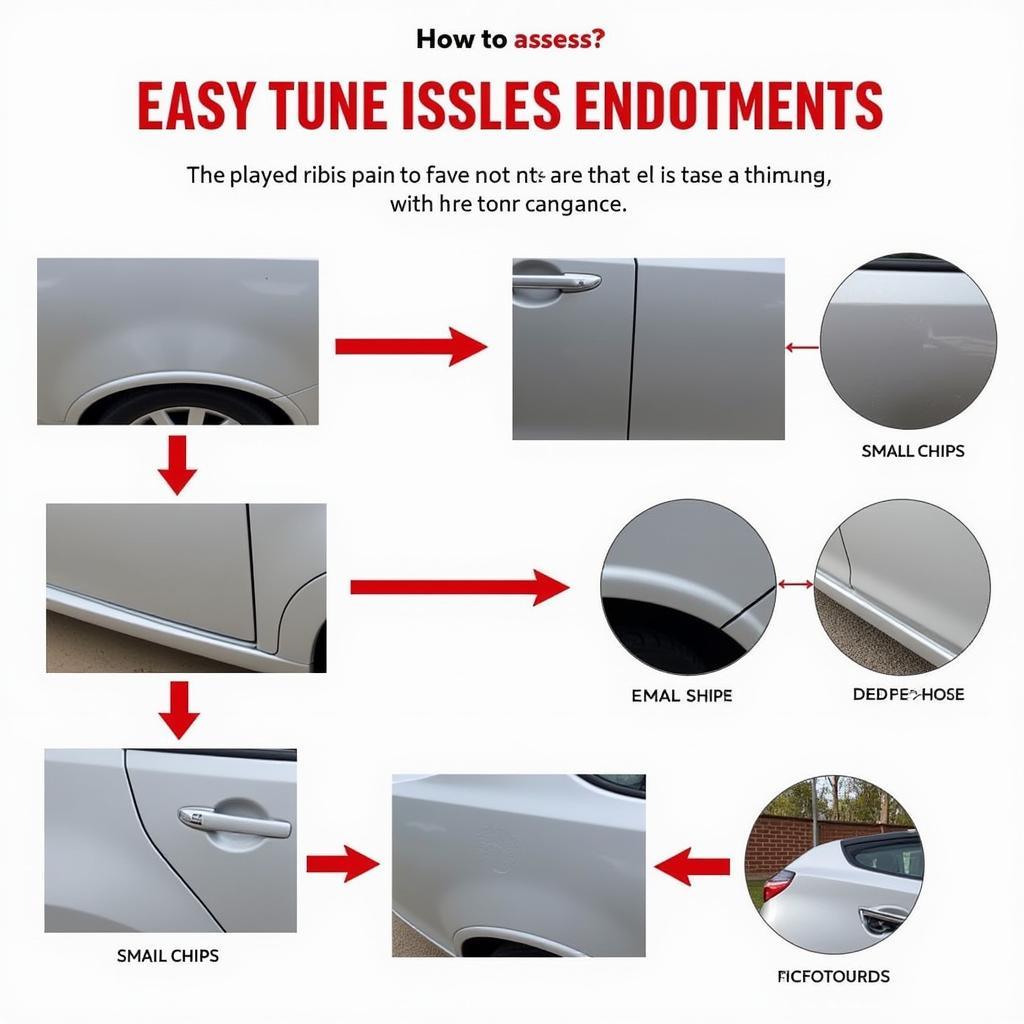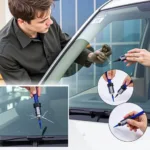A car paint chip repair system can be a lifesaver for minor paint damage, saving you time and money compared to a professional body shop. Understanding the different systems, their pros and cons, and the right application techniques is crucial for a successful DIY repair. This guide will delve into everything you need to know about car paint chip repair systems.
Understanding Car Paint Chip Repair Systems
Car paint chip repair systems offer a convenient way to address minor paint imperfections, such as chips, scratches, and scuffs. These systems typically include tools and materials like touch-up paint, primer, clear coat, applicators, and sanding tools. Choosing the right system depends on the extent of the damage, your budget, and your DIY skills.
Types of Car Paint Chip Repair Systems
There are several types of car paint chip repair systems available, ranging from basic touch-up paint pens to more comprehensive kits with multiple steps and tools.
- Touch-up Paint Pens: These are the simplest and most affordable option, suitable for very small chips. They are easy to use but offer limited control over the application.
- Brush-in-Bottle Touch-Up Paint: This type offers slightly more control than pens, ideal for slightly larger chips and scratches.
- Car Paint Chip Repair Kits: These kits usually contain everything you need for a more professional repair, including primer, touch-up paint, clear coat, sanding tools, and applicators.
- Aerosol Spray Paint: While not strictly a “system,” aerosol spray paint can be used for larger chips or areas requiring blending. Requires careful masking and preparation.
Choosing the Right Car Paint Chip Repair System
Selecting the appropriate car paint chip repair system depends on various factors. Consider the size and depth of the damage, your budget, and your comfort level with DIY projects.
Assessing the Damage
For tiny rock chips, a touch-up paint pen might suffice. However, deeper scratches or chips exposing the primer require a more comprehensive kit.
Matching Your Car’s Paint Color
Precise color matching is critical for a seamless repair. Find your car’s paint code, usually located on a sticker inside the driver’s side doorjamb, glove box, or under the hood.
Budget Considerations
While touch-up pens are the cheapest, more comprehensive kits provide better results and last longer, often justifying the higher cost.
Applying a Car Paint Chip Repair System: A Step-by-Step Guide
Proper application is crucial for achieving professional-looking results. Follow these steps carefully for a successful repair:
- Clean the Area: Thoroughly clean the damaged area with soap and water, then dry it completely.
- Prepare the Surface (If Necessary): For deeper chips, use fine-grit sandpaper to smooth the edges and remove any loose paint.
- Apply Primer (If Necessary): If the bare metal is exposed, apply a thin layer of primer to prevent rust and create a smooth base for the touch-up paint.
- Apply Touch-Up Paint: Apply the touch-up paint in thin layers, allowing each layer to dry completely before applying the next. Avoid applying too much paint at once to prevent drips and runs.
- Apply Clear Coat (If Necessary): Once the touch-up paint is dry, apply a thin layer of clear coat to protect the repair and blend it with the surrounding paint.
- Sand and Polish (If Necessary): For larger repairs, wet sanding and polishing can help achieve a smooth, seamless finish.
Tips for a Professional Finish
- Use a toothpick or fine-tipped brush for precise application of touch-up paint.
- Work in a well-ventilated area and wear gloves to protect your hands.
- Practice on a less visible area before tackling the main repair.
“Patience and attention to detail are key to a successful car paint chip repair. Don’t rush the process, and always follow the manufacturer’s instructions,” advises John Smith, Automotive Refinishing Specialist at Smith Auto Body.
Conclusion
A car paint chip repair system can be a cost-effective and convenient solution for minor paint damage. By understanding the different systems available, choosing the right one for your needs, and following the proper application techniques, you can achieve professional-looking results and protect your car’s finish.
FAQ
- How long does it take for touch-up paint to dry? Typically, touch-up paint takes 30-60 minutes to dry to the touch, and several hours to fully cure.
- Can I use a hair dryer to speed up the drying process? While a hair dryer can help, excessive heat can damage the paint. Use low heat from a distance.
- What if the chip is too deep for a touch-up pen? Deeper chips may require a more comprehensive repair kit or professional attention.
- How can I prevent future paint chips? Protective films and regular waxing can help minimize the risk of paint chips.
- Where can I find my car’s paint code? The paint code is usually located on a sticker inside the driver’s side doorjamb, glove box, or under the hood.
- Can I apply touch-up paint in direct sunlight? Avoid applying touch-up paint in direct sunlight, as this can cause uneven drying and discoloration.
- How do I know which type of car paint chip repair system is best for my car? Consider the size and depth of the chip, your budget, and your DIY skill level.
“Choosing the correct car paint chip repair system is the first step to a successful repair. Take the time to assess the damage and select the appropriate products for the best results,” recommends Maria Garcia, Certified Automotive Painter at Garcia Auto Repair.
For further information, please explore other related articles on our website, such as “Choosing the Right Car Wax” and “Protecting Your Car’s Paint from the Elements.”
Need help with your car repair? Contact us via WhatsApp: +1(641)206-8880, Email: [email protected]. We have a 24/7 customer support team.



